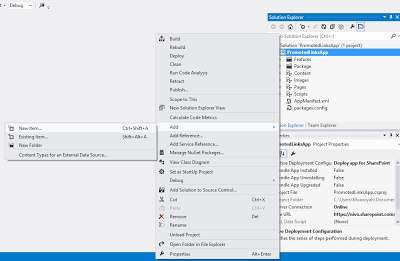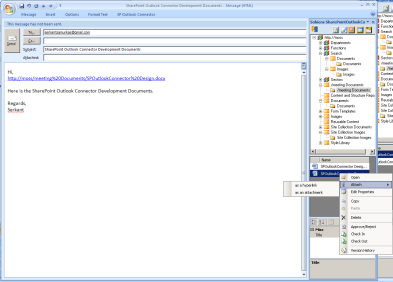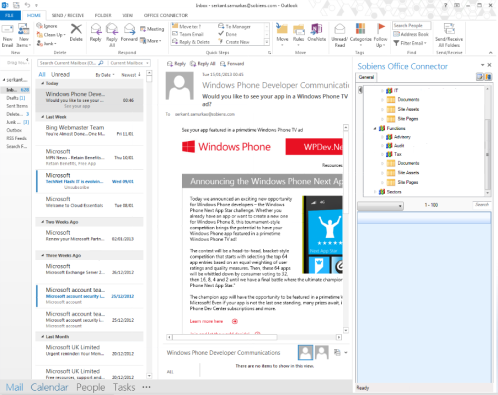<div id=”divFeaturedNews”>
<div class=”mtc-Slideshow” id=”divSlideShow” style=”width: 610px;”>
<div style=”width: 100%; float: left;”>
<div id=”divSlideShowSection”>
<div style=”width: 100%;”>
<div class=”mtc-SlideshowItems” id=”divSlideShowSectionContainer” style=”width: 610px; height: 275px; float: left; border-style: none; overflow: hidden; position: relative;”>
<div id=”divFeaturedNewsItemContainer”>
</div>
</div>
</div>
</div>
</div>
</div>
</div>
<script type=”text/javascript”>
$(document).ready(function ($) {
var basePath = “
https://richdizzcom.sharepoint.com/sites/dallasmtcauth/_api/”;
$.ajax({
url: basePath + “web/lists/GetByTitle(‘News’)/items/?$select=Title&$filter=Feature eq 1&$top=4”,
type: “GET”,
headers: { “Accept”: “application/json;odata=verbose” },
success: function (data) {
var listData = data.d.results;
for (i = 0; i < listData.length; i++) {
getItemDetails(listData, i, listData.length);
}
},
error: function (data) {
alert(data.statusText);
}
});
});
var processCount = 0;
function getItemDetails(listData, i, count) {
$.ajax({
url: listData[i].__metadata[“uri”] + “/FieldValuesAsHtml”,
type: “GET”,
headers: { “Accept”: “application/json;odata=verbose” },
success: function (data) {
processCount++;
var itemHtml = “<div class=’mtcItems’ id=’divPic_” + i + “‘ style=’width: 610px; height: 275px; float: left; position: absolute; border-bottom: 1px dotted #ababab; z-index: 1; left: 0px;’>”
itemHtml += “<div id=’container_” + i + “‘ style=’width: 610px; height: 275px; float: left;’>”;
itemHtml += “<a href=’#’ title='” + data.d.Caption_x005f_x0020_x005f_Title + “‘ style=’width: 610px; height: 275px;’>”;
itemHtml += data.d.Feature_x005f_x0020_x005f_Image;
itemHtml += “</a></div></div>”;
itemHtml += “<div class=’titleContainerClass’ id=’divTitle_” + i + “‘ data-originalidx='” + i + “‘ data-currentidx='” + i + “‘ style=’height: 25px; z-index: 2; position: absolute; background-color: rgba(255, 255, 255, 0.8); cursor: pointer; padding-right: 10px; margin: 0px; padding-left: 10px; margin-top: 4px; color: #000; font-size: 18px;’ onclick=’changeSlide(this);’>”;
itemHtml += data.d.Caption_x005f_x0020_x005f_Title;
itemHtml += “<span id=’currentSpan_” + i + “‘ style=’display: none; font-size: 16px;’>” + data.d.Caption_x005f_x0020_x005f_Body + “</span></div>”;
$(‘#divFeaturedNewsItemContainer’).append(itemHtml);
if (processCount == count) {
allItemsLoaded();
}
},
error: function (data) {
alert(data.statusText);
}
});
}
window.mtc_init = function (controlDiv) {
var slideItems = controlDiv.children;
for (var i = 0; i < slideItems.length; i++) {
if (i > 0) {
slideItems[i].style.left = ‘610px’;
}
};
};
function allItemsLoaded() {
var slideshows = document.querySelectorAll(“.mtc-SlideshowItems”);
for (var i = 0; i < slideshows.length; i++) {
mtc_init(slideshows[i].children[0]);
}
var div = $(‘#divTitle_0’);
cssTitle(div, true);
var top = 160;
for (i = 1; i < 4; i++) {
var divx = $(‘#divTitle_’ + i);
cssTitle(divx, false);
divx.css(‘top’, top);
top += 35;
}
}
function cssTitle(div, selected) {
if (selected) {
div.css(‘height’, ‘auto’);
div.css(‘width’, ‘300px’);
div.css(‘top’, ’10px’);
div.css(‘left’, ‘0px’);
div.css(‘font-size’, ’26px’);
div.css(‘padding-top’, ‘5px’);
div.css(‘padding-bottom’, ‘5px’);
div.find(‘span’).css(‘display’, ‘block’);
}
else {
div.css(‘height’, ’25px’);
div.css(‘width’, ‘auto’);
div.css(‘left’, ‘0px’);
div.css(‘font-size’, ’18px’);
div.css(‘padding-top’, ‘0px’);
div.css(‘padding-bottom’, ‘0px’);
div.find(‘span’).css(‘display’, ‘none’);
}
}
window.changeSlide = function (item) {
//get all title containers
var listItems = document.querySelectorAll(‘.titleContainerClass’);
var currentIndexVals = { 0: null, 1: null, 2: null, 3: null };
var newIndexVals = { 0: null, 1: null, 2: null, 3: null };
for (var i = 0; i < listItems.length; i++) {
//current Index
currentIndexVals[i] = parseInt(listItems[i].getAttribute(‘data-currentidx’));
}
var selectedIndex = 0; //selected Index will always be 0
var leftOffset = ”;
var originalSelectedIndex = ”;
var nextSelected = ”;
var originalNextIndex = ”;
if (item == null) {
var item0 = document.querySelector(‘[data-currentidx=”‘ + currentIndexVals[0] + ‘”]’);
originalSelectedIndex = parseInt(item0.getAttribute(‘data-originalidx’));
originalNextIndex = originalSelectedIndex + 1;
nextSelected = currentIndexVals[0] + 1;
}
else {
nextSelected = item.getAttribute(‘data-currentidx’);
originalNextIndex = item.getAttribute(‘data-originalidx’);
}
if (nextSelected == 0) { return; }
for (i = 0; i < listItems.length; i++) {
if (currentIndexVals[i] == selectedIndex) {
//this is the selected item, so move to bottom and animate
var div = $(‘[data-currentidx=”0″]’);
cssTitle(div, false);
div.css(‘left’, ‘-400px’);
div.css(‘top’, ‘230px’);
newIndexVals[i] = 3;
var item0 = document.querySelector(‘[data-currentidx=”0″]’);
originalSelectedIndex = item0.getAttribute(‘data-originalidx’);
//annimate
div.delay(500).animate(
{ left: ‘0px’ }, 500, function () {
});
}
else if (currentIndexVals[i] == nextSelected) {
//this is the NEW selected item, so resize and slide in as selected
var div = $(‘[data-currentidx=”‘ + nextSelected + ‘”]’);
cssTitle(div, true);
div.css(‘left’, ‘-610px’);
newIndexVals[i] = 0;
//annimate
div.delay(500).animate(
{ left: ‘0px’ }, 500, function () {
});
}
else {
//move up in queue
var curIdx = currentIndexVals[i];
var div = $(‘[data-currentidx=”‘ + curIdx + ‘”]’);
var topStr = div.css(‘top’);
var topInt = parseInt(topStr.substring(0, topStr.length – 1));
if (curIdx != 1 && nextSelected == 1 || curIdx > nextSelected) {
topInt = topInt – 35;
if (curIdx – 1 == 2) { newIndexVals[i] = 2 };
if (curIdx – 1 == 1) { newIndexVals[i] = 1 };
}
//move up
div.animate(
{ top: topInt }, 500, function () {
});
}
};
if (originalNextIndex < 0)
originalNextIndex = itemCount – 1;
//adjust pictures
$(‘#divPic_’ + originalNextIndex).css(‘left’, ‘610px’);
leftOffset = ‘-610px’;
$(‘#divPic_’ + originalSelectedIndex).animate(
{ left: leftOffset }, 500, function () {
});
$(‘#divPic_’ + originalNextIndex).animate(
{ left: ‘0px’ }, 500, function () {
});
var item0 = document.querySelector(‘[data-currentidx=”‘ + currentIndexVals[0] + ‘”]’);
var item1 = document.querySelector(‘[data-currentidx=”‘ + currentIndexVals[1] + ‘”]’);
var item2 = document.querySelector(‘[data-currentidx=”‘ + currentIndexVals[2] + ‘”]’);
var item3 = document.querySelector(‘[data-currentidx=”‘ + currentIndexVals[3] + ‘”]’);
if (newIndexVals[0] != null) { item0.setAttribute(‘data-currentidx’, newIndexVals[0]) };
if (newIndexVals[1] != null) { item1.setAttribute(‘data-currentidx’, newIndexVals[1]) };
if (newIndexVals[2] != null) { item2.setAttribute(‘data-currentidx’, newIndexVals[2]) };
if (newIndexVals[3] != null) { item3.setAttribute(‘data-currentidx’, newIndexVals[3]) };
};
</script>
![sap_integration_en_round[1]](https://sharepointsamurai.files.wordpress.com/2014/09/sap_integration_en_round1.jpg?w=300&h=155)
![ppt_img[1]](https://sharepointsamurai.files.wordpress.com/2014/10/ppt_img1.gif?w=300&h=225)



![Windows_Azure_Wallpaper_p754[1]](https://sharepointsamurai.files.wordpress.com/2014/09/windows_azure_wallpaper_p7541.jpg?w=300&h=225)
![office365logoorange_web[1]](https://sharepointsamurai.files.wordpress.com/2014/09/office365logoorange_web1.png?w=300&h=194)
 Prerelease content
Prerelease content

![IC648720[1]](https://sharepointsamurai.files.wordpress.com/2014/09/ic6487201.gif?w=300&h=181)



![office365[1]](https://sharepointsamurai.files.wordpress.com/2014/05/office3651.png?w=300&h=205)



.png)

.png)
.png)
.png)






 Figure 1. Wikipedia app in Word
Figure 1. Wikipedia app in Word


 Although your inserted text takes the document formatting, you must insert HTML to do app-specific styling.
Although your inserted text takes the document formatting, you must insert HTML to do app-specific styling.
 Once those two checks have successfully completed, go ahead and insert your data.
Once those two checks have successfully completed, go ahead and insert your data. The status property of AsyncResult (result in the above code sample) returns an AsyncResultStatus enumeration, which indicates success or failure by its type.
The status property of AsyncResult (result in the above code sample) returns an AsyncResultStatus enumeration, which indicates success or failure by its type. Figure 1. Configure remote event and workflow debugging
Figure 1. Configure remote event and workflow debugging Figure 2. Prompt for a connection string
Figure 2. Prompt for a connection string